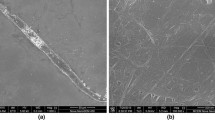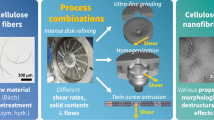Abstract
This study examined in detail the utility and validity of water retention value (WRV) for characterizing the extent of fibrillation of micro and nanofibrils. A bleached pulp fiber sample was either refined to different degrees using a PFI mill or milled for different time periods using a SuperMassColloider (SMC), to produce micro and nanofibril samples. These fibril samples were then characterized by electronic microscopic imaging (SEM and TEM), degree of polymerization (DP), Canadian Standard Freeness (CSF), enzymatic adsorption (EA), enzymatic cellulose digestibility (ED), as well as WRV measured under different relative centrifugation forces and durations. The results showed that WRV characterization is consistent with SEM and TEM imaging and correlate to sample DP, EA, and ED. CSF is a good measure for fiber samples, but is not sensitive and not suitable for characterizing microfibrils and nanofibrils. DP is a good measure of cellulose chain length or fiber cutting, but is not a sensitive measure for extensive fibrillation. The results also indicate that the centrifugation condition did not affect the effectiveness of WRV for characterizing fibril samples, as long as all samples were tested under the same conditions. A mild centrifugation condition, e.g., 3000g for 15 min, appears to have better sensitivity for characterizing fibril samples.





Similar content being viewed by others
References
Abdul Khalil HPS, Davoudpour Y, Islam MN, Mustapha A, Sudesh K, Dungani R, Jawaid M (2014) Production and modification of nanofibrillated cellulose using various mechanical processes: a review. Carbohydr Polym 99(1):649–665
Bradford M (1976) A rapid and sensitive for the quantitation of microgram quantities of protein utilizing the principle of protein-dye binding. Anal Biochem 72(1):248–254
Dekker J (2003) New insights in beating leading to innovative beating techniques PIRA 2003 refining conference, Stockholm, Sweden
Fukuzumi H, Saito T, Iwata T, Kumamoto Y, Isogai A (2008) Transparent and high gas barrier films of cellulose nanofibers prepared by TEMPO-mediated oxidation. Biomacromolecules 10(1):162–165
Gary C (2013) Optical methods for the quantification of the fibrillation degree of bleached MFC materials. Micron 48:42–48
Hartman RR (1985) Mechanical treatment of pulp fibers for paper property development. The 8th fundamental research symposium: PaperMaking raw materials, Oxford, England Mechanical Engineering Publications Limited
Henriksson M, Henriksson G, Berglund LA, Lindström T (2007) An environmentally friendly method for enzyme-assisted preparation of microfibrillated cellulose (MFC) nanofibers. Eur Polym J 43(8):3434–3441
Hirn U, Bauer W (2006) A review of image analysis based methods to evaluate fiber properties. Lenzing Ber 86:96–105
Hu C, Zhao Y, Li K, Zhu JY, Gleisner R (2015) Optimizing cellulose fibrillation for the production of cellulose nanofibrils by a disk grinder. Holzforchung 69(8):993–1000
Hui L, Liu Z, Ni Y (2009) Characterization of high-yield pulp (HYP) by the solute exclusion technique. Bioresour Technol 100(24):6630–6634
Jaturapiree A, Ehrhardt A, Groner S, Öztürk HB, Siroka B, Bechtold T (2008) Treatment in swelling solutions modifying cellulose fiber reactivity—part 1: accessibility and sorption. Macromol Symp 262(1):39–49
Jia C, Chen L, Shao Z, Agarwal UP, Hu L, Zhu JY (2017) Using a fully recyclable dicarboxylic acid for producing dispersible and thermally stable cellulose nanomaterials from different cellulosic sources. Cellulose 24(6):1–16
Kerekes RJ (2005a) Characterizing refining action in PFI mills. Tappi J 4(3):9–14
Kerekes RJ (2005b) Characterizing refining actions: Linking the process to refining results. PIRA 2005 refining conference Barcelona, Spain
Lips S, Heredia G, Kamp R, Dam J (2009) Water absorption characteristics of kenaf core to use as animal bedding material. Ind Crops Prod 29(1):73–79
Liu H, Zhu JY, Chai XS (2011) In situ, rapid, and temporally resolved measurements of cellulase adsorption onto lignocellulosic substrates by UV–vis spectrophotometry. Langmuir 27(1):272–278
Luo X, Zhu JY, Gleisner R, Zhan HY (2011) Effect of wet pressing-induced fiber hornification on enzymatic saccharification of lignocelluloses. Cellulose 18:1339–1344
Mayr M, Eckhart R, Winter H, Bauer W (2017) A novel approach to determining the contribution of the fiber and fines fraction to the water retention value (wrv) of chemical and mechanical pulps. Cellulose 24(7):3029–3036
Mazumder BB, Ohtani Y, Cheng Z, Sameshima K (2000) Combination treatment of kenaf bast fiber for high viscosity pulp. J Wood Sci 46:364–370
Moon RJ, Martini A, Nairn J, Simonsen J, Youngblood J (2011) Cellulose nanomaterials review: structure, properties and nanocomposites. Chem Soc Rev 40(7):3941–3994
Nair SS, Zhu JY, Deng Y, Ragauskas AJ (2014) High performance green barriers based on nanocellulose. Sustain Chem Process 2(1):1–7
Nogi M, Iwamoto S, Nakagaito AN, Yano H (2010) Optically transparent nanofiber paper. Adv Mater 21(16):1595–1598
Qin Y, Qiu X, Zhu JY (2016) Understanding longitudinal wood fiber ultra-structure for producing cellulose nanofibrils using disk milling with dilute acid prehydrolysis. Sci Rep 6:35602
Qing Y, Sabo R, Zhu JY, Agarwal U, Cai Z, Wu Y (2013) A comparative study of cellulose nanofibrils disintegrated via multiple processing approaches. Carbohydr Polym 97(1):226–234
Roffael E, Kraft R (2012) Influence of thermal wood modification on the Water Retention Value (WRV). Eur J Wood Wood Prod 70(1):393–395
Scallan AM, Carles JE (1972) The correlation of the water retention value with the fibre saturation point. Nature 358(6387):543–544
Sehaqui H, Zhou Q, Ikkala O, Berglund LA (2011) Strong and tough cellulose nanopaper with high specific surface area and porosity. Biomacromolecules 12(10):3638–3644
TAPPI Standard Test Method (1996) T248 cm-85, Laboratory beating of pulp (PFI mill method)
TAPPI Standard Test Method (1999a) T230 om-99, Viscosity of pulp (capillary viscometer method)
TAPPI Standard Test Method (1999b) T227 om-99, Freeness of pulp (Canadian standard method)
TAPPI Useful Method UM 256 (2011) Water retention value (WRV)
Wang QQ, Zhu JY (2015) Facile preparation of nanofiller-paper using mixed office paper without deinking. Tappi J 14(3):167–174
Wang Q, Zhu JY (2016) Effects of mechanical fibrillation time by disk grinding on the properties of cellulose nanofibrils. Tappi J 15(6):419–423
Wang QQ, He Z, Zhu Z, Zhang YH, Ni Y, Luo XL, Zhu JY (2012a) Evaluations of cellulose accessibilities of lignocelluloses by solute exclusion and protein adsorption techniques. Biotechnol Bioeng 109(2):381–389
Wang QQ, Zhu JY, Gleisner R, Kuster TA, Baxa U, McNeil SE (2012b) Morphological development of cellulose fibrils of a bleached eucalyptus pulp by mechanical fibrillation. Cellulose 19(5):1631–1643
Wang W, Mozuch MD, Sabo RC, Kersten P, Zhu JY, Jin Y (2015a) Production of cellulose nanofibrils from bleached eucalyptus fibers by hyperthermostable endoglucanase treatment and subsequent microfluidization. Cellulose 22:351–361
Wang W, Sabo R, Mozuch M, Kersten P, Zhu JY, Jin Y (2015b) Physical and mechanical properties of cellulose nanofibril films from bleached eucalyptus pulp by endoglucanase treatment and microfluidization. J Polym Environ 23:551–558
Weise U, Maloney T, Paulapuro H (1996) Quantification of water in difference states of interaction with wood pulp fibres. Cellulose 3:189–202
Acknowledgments
We acknowledge the financial support by a USDA Agriculture and Food Research Initiative (AFRI) Competitive Grant (No. 2011-67009-20056), Natural science fund for colleges and universities in Jiangsu Province (No. 16KJB180029), Jiangsu Provincial Key Lab of Bioenergy and Biomaterial Fund (No. JSBEM201607). We also acknowledge Nancy Ross Sutherland and Thomas Kuster of FPL for PFI refining and SEM imaging, respectively, and Debra Sherman of DS imaging LLC, West Lafayette, IN, for TEM imaging.
Author information
Authors and Affiliations
Corresponding author
Electronic supplementary material
Below is the link to the electronic supplementary material.
Rights and permissions
About this article
Cite this article
Gu, F., Wang, W., Cai, Z. et al. Water retention value for characterizing fibrillation degree of cellulosic fibers at micro and nanometer scales. Cellulose 25, 2861–2871 (2018). https://doi.org/10.1007/s10570-018-1765-8
Received:
Accepted:
Published:
Issue Date:
DOI: https://doi.org/10.1007/s10570-018-1765-8




